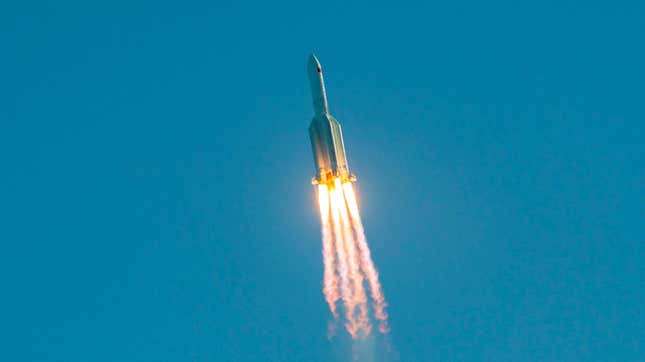
After days of fretting over when and where an out-of-control Chinese rocket would land as it fell back to Earth, China announced early Sunday that the rocket had landed in the Indian Ocean near the Maldives. Although it was unclear whether the debris had caused any damage, NASA sharply scolded China for failing to be responsible with its space debris.
In a statement released on Sunday after the debris landed, NASA administrator Bill Nelson said that spacefaring nations had to minimize the risks to people and property on Earth when it comes to re-entries of space objects. Nelson also maintained that it was important to maximize transparency regarding these re-entries. In this case, the space debris consisted of the core stage of a Long March 5B rocket, which was 98 feet (30 meters) long and 16 feet (5 meters) wide.
With a weight of 23 tons, the core stage is one of the biggest human-made objects to ever perform an uncontrolled reentry.
“It is clear that China is failing to meet responsible standards regarding their space debris,” Nelson said. “It is critical that China and all spacefaring nations and commercial entities act responsibly and transparently in space to ensure the safety, stability, security, and long-term sustainability of outer space activities.”
Experts had been watching the rocket closely in recent days, concerned over the possibility, albeit very small, of the debris falling over inhabited areas. Nonetheless, the odds were always strongly leaning towards the debris falling into an ocean, which cover the majority of Earth, or onto uninhabited areas.
China’s Manned Space Agency said in a statement on Sunday, which can only be viewed on the Wayback Machine because the website was down at the time of publication, that the vast majority of the Long March 5B burned up during reentry.
China launched the Long March 5B at the end of April as a part of its ambitious project to create its own space station, which will be named Tiangong. The Long March 5B was carrying the 55-foot (16 meter) Tianhe, or Harmony of the Heavens, which is the main module of the station. If everything goes as planned, Tianhe will be the part of the station that will house China’s astronauts, who will stay in the station for periods of up to half a year.
The Tianhe launch was the first of 11 scheduled launches needed to make Tiangong operational by late 2022.
So, how did we end up with an uncontrolled Long March 5B? In this case, the core stage of the Long March 5B carried and released the Tianhe module into orbit. (Several smaller boosters dropped off shortly after launch and landed safely in the Pacific Ocean). After releasing the Tianhe module, China chose not to fire the engine of the Long March 5B so that it could drop out of orbit and eventually land in an unoccupied area. This caused the core stage to make an uncontrolled reentry.
This isn’t the first time we’ve seen a Chinese Long March 5B make an uncontrolled reentry. Last year, a Long March 5B carrying a prototype of China’s next-generation crew capsule went through the same thing. That incident resulted in debris from the rocket damaging several buildings on the Ivory Coast, although there were thankfully no reported casualties.
Considering that China’s space station project, more launches of the Long march 5B are expected. Therefore, there’s a chance that this could happen again. It’s also possible that future uncontrolled reentries could cause serious harm on Earth. The possibility not only warrants NASA’s statement, but makes it necessary.
“An ocean reentry was always statistically the most likely. It appears China won its gamble (unless we get news of debris in the Maldives). But it was still reckless,” said Jonathan McDowell, an astrophysicist at the Harvard-Smithsonian Center for Astrophysics.